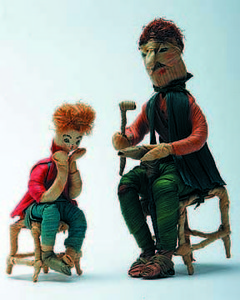

Sample of Emma Marshall's cornshuck dolls.
Cornshuck dolls didn't originate in Southwest Virginia, but they were probably perfected there on Sandy Ridge, a hilltop community in Wise County above the small towns of Coeburn and St. Paul. Emma Marshall, a young wife and mother, happened to be attending a craft workshop there at Grace House-on-the-Mountain when she saw her first small doll made of corn shucks. It was during the 1930s, and The Great Depression, as elsewhere, was making life hard in the mountains. President Roosevelt's New Deal was providing some relief through road projects and civic initiatives. Churches sought to fill in the gaps and created mission schools that brought other ways to create an income, however small, to the mountain people, including women.
Grace House was one of these missions, sponsored by the Episcopal Diocese of Southwestern Virginia and staffed by deaconesses. Their programs included craft activities such as quilting, weaving and carving. There was a national interest at this time in old-time crafts, a revival of appreciation for everything old-fashioned and handmade. It was believed that the mountain people, isolated from modern ways by sheer geography, had never left off making these old-time things, and thus there was to be found in the Appalachian Mountains a pure, unspoiled and thoroughly American heritage of material culture.
This renewed interest in mountain craft had become nationally recognized and spawned major efforts to help the mountain economy with income based on crafts, largely produced at home or through organized groups like the mission schools or under the sponsorship of entities such as the new Southern Highland Handicraft Guild and John C. Campbell Folk School in western North Carolina and Arrowmont Settlement School in Tennessee.
It could have been Mabel Mansfield who was the deaconess in charge the day Emma Marshall attended the mission class at Grace House, but whoever it was brought in a cornshuck doll as an example of something new to make. Many of the deaconesses were from New England and, when going home for a visit, would show off the crafts made by their students in Southwest Virginia as well as take craft objects back with them to the mountains. So it was that Emma Marshall was at Grace House that day when a New England cornshuck doll was displayed. She took the doll apart and then made a better version of it herself. It was so good that Mabel Mansfield placed an order right there on the spot for three dozen cornshuck dolls. From that day forward, Emma made exquisite cornshuck dolls, including farmers hoeing and plowing, women spinning or tending babies, as well as nativity scenes and nursery rhyme figures.
Emma taught her sister-in-law, Lila, as well as her daughter-in-law, Ganell, to make the dolls, thus ensuring the continuum of this friendly folk craft. "Cobbler at Work" coupled with the nursery rhyme figure, "Little Jackie Horner," are shown here and illustrate the gifted talent of Emma Marshall.
Emma Marshall, Cornshuck Dollmaker is adapted from "Backcountry Makers: An Artisan History of Southwest Virginia & Northeast Tennessee." This is the seventh in a series of articles related to this new book by Betsy K. White. Featuring more than 200 color images, it is in publication by the University of Tennessee Press. "Backcountry Makers" is White's second book on the history of the region's material culture. The first, "Great Road Style: the Decorative Arts Legacy of Southwest Virginia & Northeast Tennessee "was published in 2006 by the University of Virginia Press.